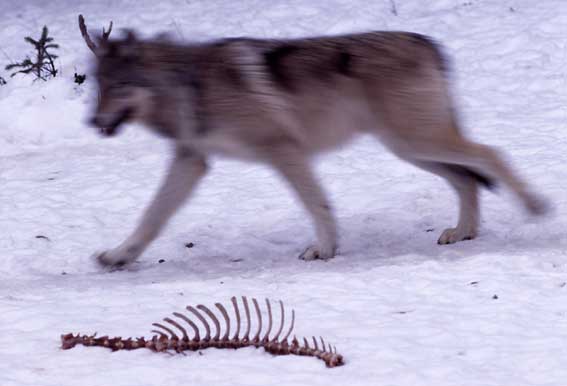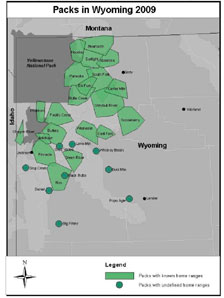PACKS
Current
Count | Daniel
Pack | Green
River Pack | Big
Piney Pack
Gros Ventre Pack | Black
Butte Pack | East
Fork Pack
Sublette County wolf pack histories from the U.S. Fish
and Wildlife Service annual wolf report for 2009
Current Count: Wolf
Packs in Wyoming outside YNP in 2009
(From the U.S. Fish and Wildlife Service annual report
for Wyoming 2009).
Nineteen confirmed wolf packs had their territories in
northwest Wyoming with relatively high native ungulate
densities and relatively low seasonal exposure to domestic
livestock. Livestock depredations in these areas were relatively
few and sporadic in 2009. Pack size and composition were
based on U.S. Fish and Wildlife Service estimates as of
31 December 2009.
1) Antelope Pack: (5 wolves:
5 adults/0 pups) The Antelope
Pack formed in 2008 when
wolves split off from the adjacent Huckleberry Pack. The
pack denned in 2009 and
produced >2 pups, but the entire pack became infested
with Sarcoptes scabiei (mange).
By December, 2 adult wolves died of unknown causes and
it appeared that no pups
survived.
2) Beartooth Pack: (5 wolves: 2 adults/3 pups) The Beartooth
Pack was involved in
numerous livestock depredations in 2008 and 2007; however,
in 2009 no depredations
were reported in the pack’s home range. A radio collared
adult male wolf dispersed from
the Steel Mountain Pack in central Idaho in 2007 and paired
with a female wolf from the
Beartooth Pack in 2008. The pair produced pups in 2009.
3) Bold Mountain Pack: (2 wolves) Agency reports led to
the documentation of this pack
in late summer 2008. Numerous photos taken from remote
sensing cameras have
consistently shown 2 wolves traveling together in the area.
Reproduction was not
confirmed and little is known about this pack. USFWS biologists
and personnel from the
Wind River Indian Reservation attempted to identify movement
patterns of these wolves,
but were unsuccessful. Sporadic reports of wolves in the
area will be monitored.
4) Buffalo Pack: (22 wolves: 8 adults/14 pups) The Buffalo
Pack formed in 2006 and
usurped the Teton Pack from their territory the same winter.
The pack normally produced
large litters, but only 2 pups survived in 2008. The pack
produced a double litter of 14
pups in spring 2009 and their home range continued to include
GTNP and the adjacent
national forest. The pack killed 3 lion hounds in the Gros
Ventre drainage in November
2009.
5) Elk Fork Creek Pack: (5 wolves: 3 adults/2 pups) This
pack was documented in 2008
when a radio collared wolf dispersed from the Pahaska Pack.
The pack was occasionally
exposed to livestock, but no livestock depredations were
reported in 2009
6) Gooseberry Pack: (8 wolves: 4 adults/4 pups) The Gooseberry
Pack formed in 2006
when the lone remaining wolf from the Owl Creek Pack paired
with another wolf. The
new pack was implicated in numerous depredations in 2006
and 2007. The entire pack of
6 wolves was removed in control actions in 2008 after they
repeatedly killed cattle. A
new pack formed in 2009 but was not involved in any livestock
depredations that year.
7) Greybull River Pack: (7 wolves: 4 adults/3 pups) The
home range of the Greybull
River Pack includes areas where large numbers of cattle
graze. The pack has been
involved in chronic depredations since 2003. In 2007, 8
wolves were controlled for
confirmed depredations of 2 cattle. At least 1 cow was
killed in 200removed. No depredations were reported in
2009.
8) Gros Ventre Pack: (3 wolves: 3 adults/0 pups) This
small pack has persisted for
several years in the Gros Ventre drainage. Given the several
large adjacent packs in the
area and the many potential young dispersers within these
packs, it is likely that the Gros
Pack will increase next year.
9) Hoodoo Pack: (10 wolves: 6 adults/4 pups) The Hoodoo
Pack formed in 2009 after
repeated livestock depredations in the Sunlight Basin led
to the removal of the entire
Crandall Pack and most of the Sunlight Pack in 2008. The
Hoodoo Pack produced pups
in 2009 and was not involved in any livestock depredations.
Two radio collared wolves
from the pack dispersed to the Lamar Valley in YNP.
10) Lava Mountain Pack: (7 wolves: 3 adults/4 pup) USFWS
has received reports of
wolves in this area since 2006. In summer 2009, USFWS biologists
found a rendezvous
site and confirmed 3 adults and 4 pups.
11) Pacific Creek Pack: (14 wolves: 10 adults/4pups) The
Pacific Creek Pack was first
documented in 2004. Mange was found on two members of this
pack in winter 2006
during capture efforts, but mange was not found on Pacific
Creek wolves in 2008 or
2009.
12) Pahaska Pack: (9 wolves: 5 adults/4 pups) The Pahaska
Pack was first documented
in 2007. Radio contact with the Pahaska Pack was lost when
the only radio collared wolf
in the pack dispersed >150 miles to southern WY. The
Pahaska Pack was not involved in
any livestock conflicts in 2007, 2008, or 2009, but they
killed a hiker’s dog in 2009.
13) Phantom Springs Pack: (9 wolves: 5 adults/4
pups) Numerous
agency and citizen
reports led to the documentation of this pack in 2008.
This pack possibly formed from
members of the Huckleberry Pack. The pack’s home
range is mostly in GTNP; however,
the pack makes occasional long distance movements in the
winter to southern YNP.
14) Pinnacle Peak Pack: (14 wolves: 8 adults/6
pups) The
Pinnacle Peak Pack was
documented in fall 2007 when a 2-year old radio collared
female dispersed from the
Buffalo Pack. The pack’s home range includes the
National Elk Refuge and the Granite
Creek drainage near Bondurant, WY.
15) Popo Agie Pack: (2 wolves/0 pups) Wolves were confirmed
in the Sinks Canyon area
in 2008, with reports of at least 2 wolves. We continuously
received reports of these
wolves, but we have not been able to confirm pack size
or pack composition.
16) Rim Pack: (6 wolves: 4 adults/2 pups) This pack was
first discovered in April 2008
when a 3-year old radio collared male dispersed from the
Pinnacle Peak Pack. The pack
produced pups in 2008 and 2009.
17) Sunlight Pack: (4 wolves: 2 adults/2 pups) The Sunlight
Pack has occasionally killed
livestock in the past, but during summer 2008 the pack
repeatedly killed cattle on private
property and public grazing allotments. All but 4 wolves
were removed from this pack in
2008 in an effort to stop depredations. Mange has been
documented in this pack since
2003. The pack persisted in 2009 and no depredations were
reported within their home
range.
18) Washakie Pack: (10 wolves: 6 adults/4 pups) The Washakie
Pack has existed since
1997 and has been implicated in numerous depredations.
A public grazing allotment that
overlapped the pack’s home range was retired in 2008,
and no depredations were reported
in 2009.
19) Whiskey Basin Pack: (3 wolves) This pack was first
documented in winter 2008.
Numerous photos consistently show 3 wolves. Despite considerable
field efforts, we have
not been able to document reproduction or pack composition.
Home ranges of 14 wolf packs in WY whose home ranges
overlapped areas where large
numbers of domestic livestock grazed on private and public
lands were involved in at
least 1 depredation in 2009.
1) Absaroka Pack: (4 wolves: 2 adults/2 pups) Due to
chronic depredations, all but 2
wolves were removed from the Absaroka Pack in control
actions in 2007. The pack
reformed in 2008, and 2 more wolves were removed after
2 confirmed depredations. This
pack continues to persist in spite of chronic mange infestations
and repeated cattle
depredations. In 2009, 4 wolves were removed after the
pack killed 4 cattle.
2) Big Piney Pack: (5 wolves) Multiple wolves were found
near Big Piney region in fall
2008 and in 2009. Depredations have been chronic in this
area in the past, but no
depredations were confirmed in 2007 or 2008. One calf
was killed in 2009. We couldn't confirm reproduction
or pack composition.
3) Black Butte Pack: (3 wolves: 1 adult/2 pups) This pack
formed and reproduced in
2006, but chronic depredations have led to numerous control
actions. A dispersing radio
collared male from the Jackson area was located here in
late summer 2008 with 1 other
wolf. The par produced 6 pups in 2009. After the pack
killed 37 sheep and 1 yearling steer, both adults and 4 pups were removed. The 2 remaining
pups survived and were
later joined by a dispersing, radio collared, male wolf
from the Phantom Springs Pack
near Jackson, WY.
4) Butte Creek Pack: (8 wolves: 4 adults/4 pups) This pack
was first documented in
summer 2008 when 2 radio collared wolves dispersed from
the South Fork Pack. In the
following year, the pack produced 4 pups. One wolf was
removed in 2009 after the pack
severely injured 1 cow. No further depredations were reported
after the control action.
5) Carter Mountain Pack: (4 wolves: 2 adults/2 pups) In
past years, chronic depredations
have been documented in the Carter Mountain Pack. In 2007,
all but one wolf were
removed in control actions. The pack reformed in 2008 and
killed 1 cow. Two wolves
were removed in a control action and no additional depredations
were recorded. In 2009,
the pack killed 1 calf. Given the pack’s history
of chronic depredations, 3 wolves were
removed and no further depredations occurred.
6) Chagrin River Pack: (7 wolves: 4 adults/3 pups) Wolves
were first documented in the
Driggs area in 2005 when a radio collared male dispersed
from the Teton Pack. Contact
was lost in 2006 when this collar was chewed off. In summer
2008, USFWS followed up
on reports from a hunter leading to the discovery of a
missing radio collared wolf from
the Huckleberry Pack with 5 other wolves. The pack killed
1 calf near Victor, ID in 2009.
ID WS attempted to trap and remove a wolf near the depredation
site, but were
unsuccessful. No other depredations occurred and control
effort ended.
7) Daniel Pack: (4 wolves) There were 4 wolves in the Daniel
Pack at the end of 2007. In
early 2008, this entire pack was killed by private individuals
when wolves were delisted
and WGFD designated wolves as predators in this area. There
was no evidence of
wolves in this pack at the end of 2008. The pack reformed
in 2009 and killed 1 calf. No
additional depredations occurred.
8) Dog Creek Pack: (6 wolves: 1 adult/5 pups) This pack
was discovered in summer
2008 when at least 12 sheep were killed on a public grazing
allotment. One wolf was
removed in a control action and no additional depredations
were reported. The pack
produced 6 pups in 2009 and quickly began killing sheep
once the grazing season began.
Five adult wolves were removed after the pack had killed
45 sheep and 3 guard dogs. At
the end of 2009, >1 adult and >5 pups remained in
the Dog Creek drainage.
9) East Fork Pack: (8 wolves: 4 adults/4 pups) The East
Fork Pack was first documented
in 2005, but is suspected to have been around since at
least 2004. In 2006, a radio
collared wolf dispersed from the adjacent Washakie Pack
and joined the East Fork Pack.
The East Fork Pack killed 2 cattle in 2005, 2 cattle in
2006, 6 cattle in 2007, and 2 cattle
in 2008. Three wolves were removed in control actions in
2008. In 2009, 2 calves were
killed. Depredations stopped after 2 wolves were removed.
10) Green River Pack: (8 wolves: 3 adults/5 pups) With
several thousand cattle grazing in
the Upper Green River drainage, the Green River Pack has
been removed several times
since 2002 due to chronic depredations, but new packs continue
to recolonize the area.
The pack killed >10 cattle in 2002, >9 cattle and
1 sheep in 2003, >20 cattle in 2004, >10
cattle in 2005, >27 cattle in 2006, >12 cattle in
2007, and >11 cattle and 14 sheep in
2008. Control actions were ongoing in 2008; however, no
wolves were removed. The
pack reproduced in 2009 and began killing cattle early
in the summer. By the end of the
grazing season 4 wolves were removed and there were a total
7 confirmed cattle
depredations.
11) South Fork Pack: (6 wolves: 4 adults/2 pups) The South
Fork Pack formed in 2005
and have since been implicated in chronic depredations
killing >3 cattle in 2005, >19
cattle in 2006, >1 cattle in 2007, and at least 4 cattle
in 2008. The South Fork and the
Absaroka Packs were both in the vicinity of a livestock
depredation in 2009. One wolf
from the South Fork Pack was removed and no further depredations
occurred.
Packs no longer existing or missing
1) Deer Creek Pack: A pair of wolves was
repeatedly seen during winter 2009 in
Converse County. WS unsuccessfully attempted to trap and
radio collar these wolves in
the spring after they killed a calf. We did not receive
any other reports of wolves in the
area for the rest of the year and we suspect that the wolves
no longer exist.
2) Prospect Pack: Since 2005, the Prospect Pack has been
implicated in multiple
depredations: 33 sheep in 2005, and 22 cattle in 2006.
No depredations were reported in
2007 or 2008. At the end of 2007, at least 3 wolves were
confirmed in the Prospect Pack.
Two wolves were killed while wolves were delisted and were
classified by WGFD as
predators in this area. Two wolves were repeatedly seen
in the same area in 2009. Both
wolves were removed after they killed a calf.
3) Big Horn Pack: Wolves have dispersed to the Big Horn
Mountains on numerous
occasions over the last several years; however, no packs
and no reproduction have been
confirmed. In 2007, 4 sheep were killed by wolves. Two
wolves have been inadvertently
killed by M-44’s used for coyote control. In 2009,
2-3 wolves began killing sheep on
private land in the southern Big Horn Mountains. Shoot-on-site
permits were issued to
the wool growers who lost sheep and WS repeatedly tried
to remove the offending
wolves in very difficult terrain. Three male wolves were
finally removed, but not until the
wolves killed >113 sheep. After the wolves were killed,
we discovered that one of the
wolves was radio collared and had dispersed from Montana.
4) Snake River Pack: (4 wolves:
4 adults/? pups) Reproduction
in the Snake River Pack
was not documented in 2008. Their remote location did not
allow confirmation of
reproduction or pack composition. By 2009, we suspected
the pack no longer existed.
5) Huckleberry Pack: (3 wolves: 3 adults/? pups) The Huckleberry
Pack formed in 2006
and possibly combined with the Sage Pack in 2007. Members
of this pack split and
formed the Antelope Pack and possibly the Phantom Springs
Pack. During winter 2009, a
remote camera took a photo of >6 uncollared wolves within
the old home range of the
Huckleberry Pack. It’s unclear if these wolves are
remnants of the old Huckleberry Pack
or possibly wolves from the Bechler Pack in YNP. This winter
we will attempt to radio
collar these wolves and unravel the mystery.

|





